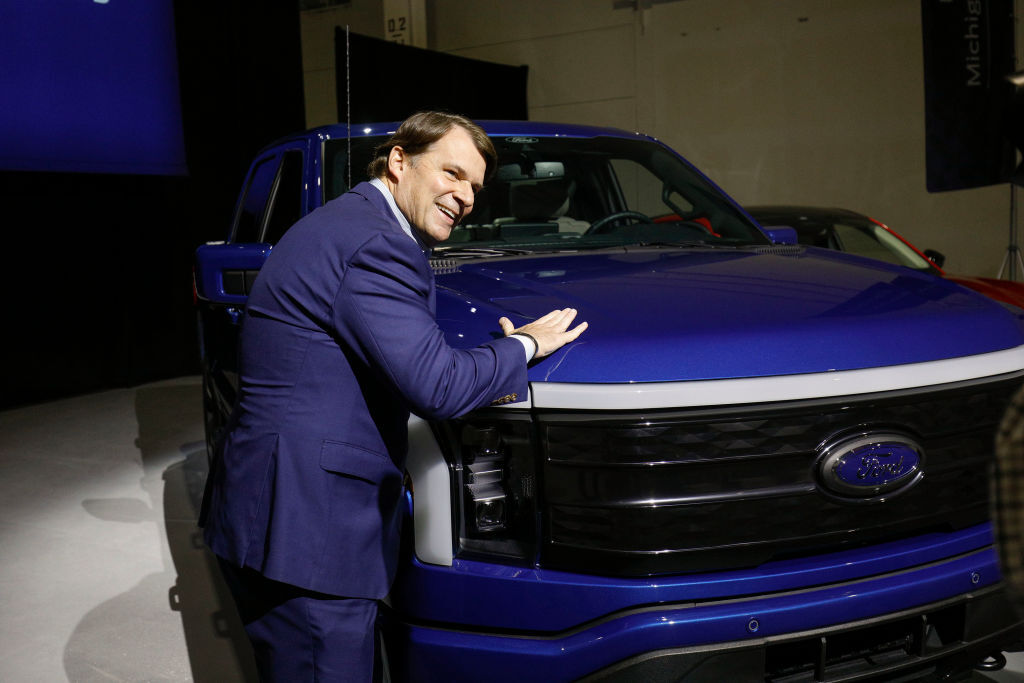
Ford is moving so fast to implement its $50 billion electric-vehicle transformation that construction workers were still installing equipment at its new electric-vehicle battery hub on Monday when the company gathered dignitaries there to announce yet another multi-billion investment. The company said it would spend $3.5 billion to build a new facility just down the road to manufacture batteries for EVs.
Over and over again, executives were clear that the development was made possible by federal climate policy. “We’re growing production of EV batteries here at home, reflecting the central purpose of the Inflation Reduction Act,” said Ford CEO Jim Farley of Biden’s landmark climate law. “That’s why it was passed, for this project.”
Less mentioned in the splashy announcement was a key collaboration that made the project possible: a partnership with Chinese battery manufacturer Contemporary Amperex Technology Co. Limited, known as CATL. The company will provide equipment and expertise necessary to launch the plant even as Ford owns 100% of the project.
The development underscores an emerging tension in the politics of climate change following the enactment of the Inflation Reduction Act (IRA). All of a sudden, and in large part thanks to the IRA, the U.S. is embracing the energy transition and developing a domestic clean-energy ecosystem. That should eventually reduce U.S. reliance on China. But it’s not something that can be done overnight. In order to build out that capacity, the U.S. needs Chinese products in the short term.
Read More: The Inflation Reduction Act Is About to Change the World.
All of that adds up to a messy political and geopolitical dynamic. Republicans have criticized the IRA for potentially increasing the demand for Chinese products as Americans rely on the country for solar panels and batteries. Meanwhile, the administration has sought to balance the urgency of deploying clean energy—even with Chinese technology—with the need to decouple the two economies.
The reliance on China didn’t emerge out of the blue. Much of the world’s early-stage research and development into clean technologies has occurred in U.S. labs, but companies often turned to China to turn those products into commercial offerings. The reasoning was simple. Over the past decade, the Chinese government offered hundreds of billions in subsidies to support manufacturing of green products. As a result, China developed a clean-technology ecosystem that could efficiently manufacture a range of clean technologies as well as a supply chain to source all the materials. The U.S. did not develop similar policies. Some leaders—think of the Trump administration—even flirted with restricting clean energy.
The result is that today China dominates the production of a range of clean-energy technologies. It has at least 60% of global manufacturing capacity for solar panels, components of wind energy systems, and batteries, according to a January report from the International Energy Agency. As of January, the country has the vast majority of new manufacturing capacity in the pipeline looking forward to 2030: 85% of wind blade capacity, 90% of solar wafer capacity, and more than 95% of anode and cathode material for EV batteries.
“We invented these technologies in the United States of America, and then waved to them as they floated offshore,” says White House National Climate Advisor Ali Zaidi. “We’re running back on the field. And the field position is not what you’d like it to be. That’s just a fact.”
The IRA is designed to change that, spurring manufacturers to set up shop in the U.S. thanks to tax incentives that favor products built in North America. But it will take time for companies to rejigger supply chains and build up domestic manufacturing capacity. Until then, they’ll still need China. “Across numerous technology areas, the level of integration is so great that true decoupling would be nearly impossible and potentially counterproductive to national interests,” a group of researchers wrote in the journal Science last year.
Which makes for complicated politics. Michigan Governor Gretchen Whitmer, a Democrat, attended the Ford announcement on Monday, touting the project as a prime example of jobs coming back to the U.S. thanks to the IRA and other recently passed legislation. “We are competing for more projects of every size,” she told the crowd on Monday.
But the association with CATL has been a non-starter for some Republicans, no matter the jobs it may bring. GOP Governor Glenn Youngkin of Virginia had previously withdrawn his state for consideration for the project, calling it a “Trojan horse” for the “Chinese Communist Party.” This tension is bound to come up again and again in the coming years as the U.S. clean energy sector continues to expand. Republicans have already begun calling for the repeal of the IRA arguing that too much of clean energy technology is made in China.
It is, of course, legitimate to worry about relying on products from China to build a domestic clean-energy economy. Geopolitical tension between the U.S. and China leaves open the possibility that China could interfere with the trade of necessary goods. It’s a concern great enough that Ford executives acknowledged the company’s contract with CATL includes provisions to address potential interference from the Chinese government.
But what’s the alternative as the U.S. builds up its own domestic clean technology industry? Waiting any longer to invest in this new future would only make the U.S. even more reliant on China in the long run.
More Must-Reads From TIME
- The 100 Most Influential People of 2024
- Coco Gauff Is Playing for Herself Now
- Scenes From Pro-Palestinian Encampments Across U.S. Universities
- 6 Compliments That Land Every Time
- If You're Dating Right Now , You're Brave: Column
- The AI That Could Heal a Divided Internet
- Fallout Is a Brilliant Model for the Future of Video Game Adaptations
- Want Weekly Recs on What to Watch, Read, and More? Sign Up for Worth Your Time
Write to Justin Worland at justin.worland@time.com